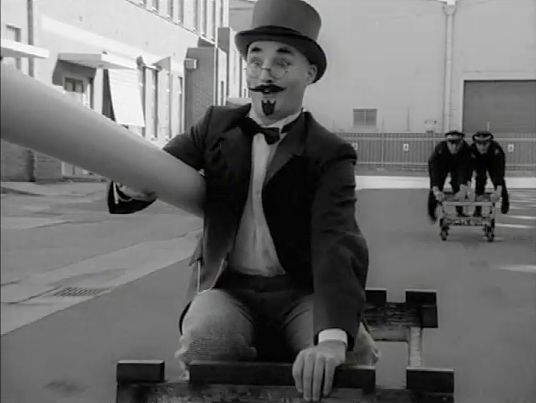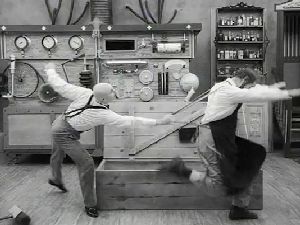Dr Plonk (Rolf de Heer, 2007)
Rolf de Heer’s new film, Dr Plonk, is built on a brave and irresistible premise. De Heer has made a real, honest-to-God silent movie, evoking about as closely as possible the feel of a silent comedy from the 1920s. The only remotely similar project I can think of is Mel Brooks’ Silent Movie, from 1976, but that film did things by halves: shooting in colour and (typically for Brooks) showing only the vaguest sympathy for the genre he was supposedly channelling. De Heer, by contrast, brings to Dr Plonk a serious filmmaker’s urging to get the little things right: the film is shot in black and white using hand-cranked cameras; the camera moves only occasionally, and is shaky when it does; there are intertitles, written with a good ear (eye?) for the style of period titles; and there’s even a slight variability in the brightness of the film that matches that seen in silent prints. The illusion is remarkable, and in the early passages, before the time-travel plot kicks in and the eponymous doctor travels o the present day, there’s really little other than the familiar face of Magda Szubanski to give this away as a contemporary production. At that level, it’s a remarkable achievement, and as a fan of silent films I really, really wanted to enjoy Dr Plonk more than I did. Unfortunately, de Heer’s film also shows up the difficulties of reviving what is basically a dead form.
Most of the problems aren’t de Heer’s fault. The first, and perhaps most serious, is that a film like this can never really get a fair go, because our whole knowledge of silent films is now based only on the absolute best examples of the form. When we see an action film like, say, The Bourne Ultimatum, we judge it against a whole range of other films in the genre, and not just the very best action films ever made. But the only silent comedies 99% of the population ever see – if they see any – are the features of Charlie Chaplin and Buster Keaton. Those two actor / filmmakers were the best comic film performers of their time, and had honed their talents over an enormous number of short films. So those of us whose principal experience of silent features is their exceptional later works place Dr Plonk in a very unforgiving frame of reference: there is simply no way that de Heer’s film can be expected compete with the best of Keaton or Chaplin. Worse, de Heer is left trying to make this hopeless match when there isn’t anyone around with any experience in this form. His cast are actually remarkably good: in the lead role of Dr Plonk, de Heer made the inspired choice of Paul Lunghi, a street performer who proves to be a natural; Paul Blackwell and Magda Szubanski also acquit themselves well. But who is there who can match, say, Charlie Chaplin’s blindfolded rollerskating in Modern Times or Buster Keaton bouncing railway sleepers off the track in The General?
Such a comparison is monumentally unfair, but the problem is that a form as stylistically minimalist as silent comedy needs big gags to hold the attention, and there really needs to be a very strong comic performer at the cnetre of the production to build jokes of that nature. Chaplin and Keaton weren’t just good comic actors: they were the principal creative personnel on their best films, and would shape the features around gags and routines they devised. De Heer’s auteurist role as a non-performing writer / director, by contrast, is much more of a sound era formulation, and is not well suited to this kind of film. While de Heer doubtlessly did what he could by encouraging his cast to improvise and have fun, the simple fact is that the jokes peppered through Dr Plonk are too mild to sustain the film. The film picks up considerably at the end, where most of the good gags are concentrated in a pratfall-laden chase scene, but for the most part the jokes are not so much gags as business: the mildly diverting bits and pieces that a comedy like this should be using to fill the gaps between its more major jokes.
The flatness of much of the film has probably been exaggerated by the need to make this a modern feature length. At 83 minutes, the film is relatively short by modern standards, but something of an epic for a silent comedy: Chaplin’s later films were in that order, but Keaton’s were not usually more than about 70 minutes and my favourite silent film of all, Sherlock Jr, is only 44 minutes long. There just isn’t a distribution mechanism any more for feature that short: some might remember the grizzling when an attempt was made a few years ago to release Rachel Perkin’s 57 minute One Night the Moon in cinemas. So instead of a zippy, gag-packed diversion, Dr Plonk is stretched out to a point that tries the patience of its audience. I suspect the film might work better on DVD, where there is more ability to pick and choose the sequences to watch, or to see it in short bursts. Those kinds of distracted viewing patterns might normally be frowned on by film purists, but in this case, they would effectively help turn Dr Plonk into the short film that it probably should have been.
I’ve dwelt on the reasons I feel the film doesn’t quite work, but having said all that Dr Plonk’s flaws don’t detract from the essential wonder of seeing a new film made in this technique. It’s a credit to de Heer that he was willing to try it, and while the film has problems, it also offers audiences something quite unlike any other film they will see in the cinemas this year.

